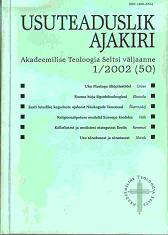Mõistujutt kahest pojast: Mt 21:28-32 erinevad tekstivariandid ja nende mõistmise võimalused
The Parable of the Two Sons: The Different Textual Versions of Matthew 21:28-32 and the Possibilities of Understanding Them
Author(s): Ain RiistanSubject(s): Christian Theology and Religion
Published by: Akadeemiline Teoloogia Selts
Keywords: New Testament Studies; Matthew
Summary/Abstract: The text of Matthew 21:28-32 is presented differently in different Estonian translations of the New Testament (NT). These differences are based on the differences found in the printed editions of the Greek NT text that were used for the translations. On the basis of NT manuscripts we can say that this pericope has had three principal textual versions. In the story the father commissions his sons to go to work at vineyard. According to version A the first son says “No”, but later goes to work. Second son says “Yes”, but does not go. Jesus asks his listeners: “Who did the will of the father?”. The answer is: “The first son”. In version B the order of sons is reversed and accordingly it is the second son who does the will of his father. In version C the order of sons is like in version A but listeners say that it was the second son who behaved rightly. Printed editions of the NT have preferred versions A or B and C has been neglected altogether. When we take a closer look at the principles of textual criticism involved, we can see that the criteria for deciding for one version over another have been mainly derived from internal evidence textual criticism. Here the main factor is the opinion of editors of what this text is about. For a long time it has been understood as an allegory and allegory demands that we choose either A or B but not C. But is it really an allegory? The questions of genre are important here. We can also see the text originally as a parable which was later allegorized. In this case it is important to decide what the point of contrast in the story is. If the contrast is between words and deeds then again versions A or B are to be preferred. But if the contrast is between two sons then version C is also plausible for it fits in well into the cultural behavioural attitudes of the time. The third option is to take the story as an example of ancient rhetorical strategies of polemics, in which case again all three versions are possible. So the neglected version C may have indeed been the original one.
Journal: Usuteaduslik Ajakiri
- Issue Year: 2003
- Issue No: 1 (51)
- Page Range: 15-44
- Page Count: 30
- Language: Estonian

